|
Resume / Brief description
|
In most of our work as lecturers or as scientists we are explaining certain system dynamics. The context can be a value chain as a business relational system, local economic development as a system in a certain geographic space or even a business itself as a system of departments, employees, changing markets and demand. Most systems are complex and interrelations in the system cannot always be traced back. The Systems Game is a funny and insightful self-experience on how systems and interrelationships are affecting each other in a multidimensional way. In the beginning, the participants of the exercise stay in a circle. They have to select two persons in the circle between which they have to position themselves once the moderator gives the signal. Different rounds of this game and joint reflections about observations provide an inside on how system dynamics function.
|
|
Implementation - Guidelines
|
The preparation is mainly the identification of a space large enough to freely make movements. Apart from that it is relevant to be aware of system dynamics and its explanation to the students or participants. The starting point of the exercise is that the students or the participants are building a circle in the space.
1. Explanation of the rules
1.1. Explaining the relevance of system dynamics
First, focus on the relevance of system dynamics and how we are acting in these dynamics. For example,
- Ask the students what the term “system dynamics” means and what systems are coming up in their mind
- Explain that we often try to fix a system without really knowing the relations in the system
- Ask participants to imagine a network of stakeholders with many connections. Moreover, let them think about what is happening when you shift or remove one stakeholder.
1.2. Explanation of rules of exercise
- All participants are already standing in a large circle in which they can all see each other.
- Everyone should choose two people in the circle without being recognised or saying anything. Please also do not look at the persons during the exercise. Tell them to put on a "Pokerface".

- As soon as the moderator or teacher claps their hands, it is the task of all participants to position themselves between the two people they have chosen. If these two people move, each participant must also reposition him or herself so that he or she is again between the two people (see graphic).
1.3. Demonstration
- The moderator selects two participants in the circle and names them. He or she asks them to move slowly in different directions in the room.
- As soon as they move, he or she constantly repositions him or herself between them.
- It is emphasised that everybody has to continue the adjustment until the moderator claps his or her hands again.
- If other people are in the way to be able move into the correct position, you will still try to move carefully into the correct position.
- When the moderator claps his or her hands again, all participants should stop moving and have to stay where they are (freeze).
2. Exercise and observations
2.1. First round of exercise
- The moderator asks all participants whether they have understood the rules and whether they have chosen two people.
- The moderator claps his or her hands and all participants take their positions. What will happen is the formation of a knot in which all participants stand very close together and move constantly.
- The moderator reminds the group to keep positioning themselves until he or she claps into the hands again.
- When the moderator claps his or her hands, everyone in the group should stand where he or she stands (freeze).
2.2. First round of reflection
- “What do you observe? What is happening?”, is the question the moderator asks the group. In general, different answers are coming up, e.g. “We are moving constantly.” "We are creating a knot?"
- The moderator asks again what else they observe? Answers could e.g. be: "It seems we are somehow connected.” "I do not know why the others are moving and where the centre of movement is.” The feeling of the complexity of the system starts to emerge.
- The moderator asks the group: Who thinks that he or she knows who is following them? They should say nothing but just raise their arm.
- The moderator asks then: Please raise the arm, if you think that nobody is following you.
2.3. Second round of exercise: Observe who is following you
- The moderator asks all participants to go back to the circle.
- The moderator then asks the persons to do the same exercise but trying to give attention to the potential persons who are following them. Can they identify of who is following them? The rule is that everybody has to position him or herself in between his or her previously selected two persons.
- The moderator claps his or her hand and the same positioning starts again like in the first round.
- After two minutes the moderator claps his or her hand to ask the participants to freeze again.
2.4. Reflection on what has happened
- The moderator asks again: "What has happened?" Further comments are coming from the participants.
- The moderator asks: “Who thinks that he or she knows who is following him or her? Please raise your hand.”
- The moderator asks: “Who thinks that he or she is not followed by anybody? Raise your hand.”
2.5. Third round of exercise: Taking stakeholders out of the system
- The moderator takes two persons out from of the centre of the group and positions them somewhere else in the room while asking everybody else to stay where they are. The persons who have been taken out of the centre are now standing still in the next round. They are freezed for a moment.
- The moderator gives the introduction that if he or she claps again into the hand the whole group of persons has to position itself again between the two earlier selected persons. The persons who have been taken out of the group are now observers and have to see if they observe something and if they maybe identify persons that are following them.
- What happens in general is that the knot gets further dissolved. If not, the moderator takes another person, who thinks that he or she is not followed, out of the group and positions him or her or even two persons into another corner of the space while the whole group has to adjust immediately.
- Finally, the moderator asks the group for a last exercise. He chooses one person, who seems very much connected from the outside. He then asks the whole group to directly react on changes. At the same time everybody has the task to try to identify again who is following them. The moderator then takes the chosen person and moves with this one through the whole room or park. What happens normally is that the whole system of participants is moving again, and relations are becoming more visible.
2.6. Third reflection on what has happened
- The moderator asks again the whole group and the persons who have been repositioned: “What do you observe? What has happened?" Observations are often that some persons who have formerly thought that they have not been followed but now realise the persons that are following them. Additionally, some persons realise some other interdependencies.
- The moderator asks the whole group again. “Who still thinks that he or she is not followed?” Then relations are getting dissolved and everybody tells whom he or she followed.
3. Final reflection
3.1. Reflection of the whole exercise and insights
- The flipchart is taken into the circle and upcoming observations are documented.
- The moderator does a summary reflection: "What did we observe in the first round?" (e.g. knot, continuous movement without clear idea of who is following whom, etc.) "What did we observe in the second round?" (e.g. dissolved knot, more clarification of some interrelations but no clarity about all relations, etc.). "What did we observe in the third round?" (e.g. persons in the system who think they are not followed are actually followed etc.).
3.2. Reflection on (additional) system dynamics aspects
- The moderator then asks: "What are the insights from this exercise on system dynamics? What does this tell us about the complexity of systems?" Comments are documented again on the flipchart.
- The moderator then gives also additional inputs on typical system dynamics (see bullet points under “Objectives” above).
3.3. Reflection on relevance for our work
- The final reflection is on the relevance of these insights on our work (e.g. on value chains, on internal dynamics in sectors, business branches, etc.).
|
|
Example of application
|
Sensitisation on local economic development (LED) at a Summer Academy on Economic Development in Germany with international experts as well as a SEPT Master Course class in Leipzig with students in a course of local economic development
The participants of the Summer Academy are all coming from different countries, but they are all representatives of either private business organisations, public entities or support organisations. Also, the students at the Master Course have got experience in different organisations. In both occasions, all of the participants have to imagine that they are now in a location to promote local economic development with very different stakeholders and different interests. The objective in this context is that participants learn that LED is about
- A complex task where relationships between key stakeholders are highly diverse and complex, often not visible really.
- Sensitising for the importance to not only do a stakeholder analysis but specially to understand the interrelationships between the stakeholders.
- Realising that competitiveness of a locality does not only depend on the competitiveness of businesses, but also requires relationships between businesses, service providers, support organisations and local government entities. Socio-cultural norms and values often define certain overall relational contexts.
- Understanding better missing interrelations where it is possible to identify potential for cooperation.
Finding a place to realise the Systems Game
In the case of the Summer Academy the moderators decided to move into the park next to the training location.
Starting point
The group starts with a large circle and the introduction and rules of the exercise documented above.
Exercise itself
Impressions from the exercise itself through the round of reflections (left side Academy, right side Master Class)
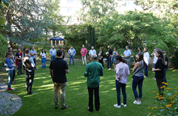 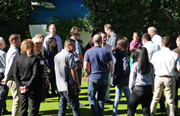
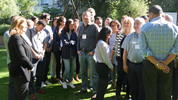 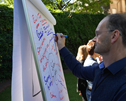
Final reflection on the flipchart
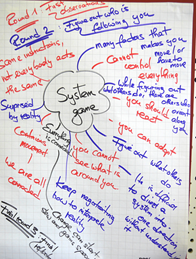
Support
The Systems Game requires especially facilitation through a moderator. It is also good to have a second moderator to document the final reflection on the flipchart. The group of participants should go beyond 12 people. It can also be facilitated with up to 50 persons to still manage a good reflection.
|

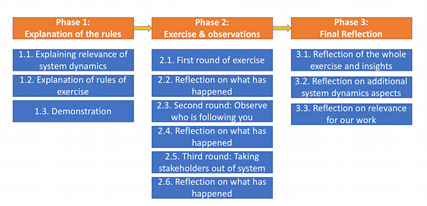






No Comments